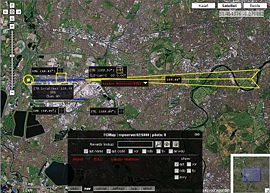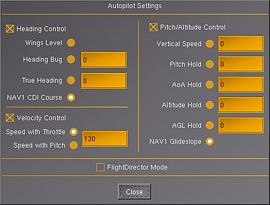Instrument Landing System Tutorial
See Instrument Landing System for the main article.
In this tutorial we will land a Boeing 737 at London Heathrow Airport (EGLL). The principle is at every airport the same, only the numbers are different. In some planes you might have to set the ILS settings by using the 3D Cockpit.
Preflight
Use these settings in the FlightGear Wizard (Advanced.. > Initial Position):
| Longitude | 0 |
| Latitude | 51.47759 |
| Altitude | 5000 |
| Heading | 270 |
| Airspeed | 350 |
MP Map
With a few modifications the MP Map is very useful for ILS landings. If we want to land at an airport we go to the 'nav'-tab and tick on the 'apt' button below 'show'. Now you'll see blue lines on the runways, a box with the name of the airport in red and a box at every end of a runway. To show the ILS info of a runway we press the square next to the runway name. Now a yellow triangle will appear. This is the area where the plane will pick up the ILS, so you need to get in this triangle to land.
Approach
With this tutorial your flight will start 12 nm out of EGLL. You're at 5000 ft and lined up with 27R. That's the runway we'll land on.
Long final
First thing to do is setting up the radio settings. We go to Equipment > Radio settings and fill our frequency (110.30) in the first NAV1 box. That's all we have to do to be sure our plane will find the ILS on 27R.
Now we need to slow down a bit and slowly descend to 2500 ft, this is the maximum height where our plane could find the ILS.
Final
Put your landing gear down at 7 miles out. Apply full flaps if you are within 4-5 nm of the airport. Try to maintain your height or descend a bit more to 2500 ft.
Autopilot
If you are with in the ILS range you could turn on the autopilot. To get your plane lined up with the runway and on the correct glideslope you have to use the settings shown on the picture on the right (the speed depends on your plane's landing speed!). Now change nothing and let the ILS do its work. Watch your plane lining up perfectly with the runway and see it descend slowly.
Touch down
A few seconds before you touch down (let's say on a height of 150 ft) you should turn off the autopilot and manually land the plane. If not, your plane may crash. Use thrust reversers, airbrakes and brakes to slow your plane down. Vacate the runway as directed by the air traffic controller.

